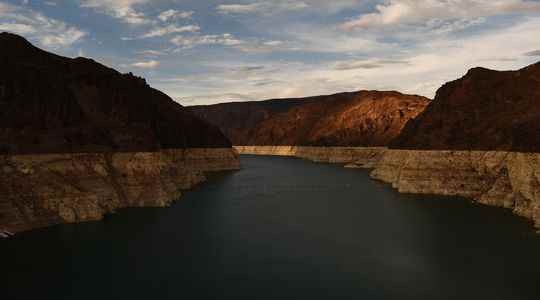These days, boaters cruising Lake Mead are making some amazing discoveries. A badly decomposed corpse was recently found in an old rusty can. A week later, two women discovered human bones on a sandbar.
Created in the 1930s on the Colorado River, between Nevada and Arizona, Lake Mead is the largest water reservoir in the United States. But its level is dropping dangerously: it has fallen nearly 55 meters since 1983, judging by the white mark left on the cliffs surrounding the lake. To the point that it is now at a quarter of its capacity, a historic record. The fault is the terrible drought of the last two decades, the worst in 1,200 years, exacerbated by global warming and the enormous increase in the population’s water needs.
The narrowing of the lake brought to light all sorts of finds: baby strollers, dozens of shipwrecks – including a barge similar to those used during the Normandy landings – but also arrowheads, concrete mooring blocks, plastic skeletons placed by diving instructors to titillate their students. And even, therefore, real corpses.
A mysterious corpse
On May Day emerged the remains of an individual who had been shot and stuffed into a barrel – one of the mafia’s favorite methods – before being thrown from a boat. According to the brand of his shoes and clothes bought in a Kmart supermarket, the police estimate that he was killed between 1975 and the beginning of the 1980s. This is not surprising. The reservoir is not far from Las Vegas, a mecca of the underworld at that time, and served as a dumping ground for gangsters. A group of philanthropists donated $5,000 to carry out a DNA analysis of the bones, hoping to determine the identity of the unfortunate. Because speculation is rife. Is it George “Jay” Vandermark, charged by the mafia to monitor the Stardust slot machines, and who vanished after filling his pockets? Or Johnny Pappas, a Chicago gangster, owner of a local hotel, who disappeared in 1976?
In the meantime, the depletion of the reservoir is gradually killing tourism and yachting. Above all, it has serious consequences for more than 25 million households, located in Arizona, California, Nevada and part of Mexico, which depend on its water supply. Not to mention the farmers. The drying up has already caused a drop in hydroelectricity production. Authorities in several states have imposed restrictions, particularly on watering. In California, this ultimately threatens part of the fruit and vegetable crops, which respectively represent two-thirds and one-third of national production. “The Colorado River Basin faces far greater risks today than at any other time in our history,” said Tanya Trujillo, an Interior Department official. And the lake level is expected to continue to decline. For it to rise again, it would take at least ten years of heavy snowfall in the mountains of Colorado.
This announced disappearance arouses the interest of certain archaeologists. Because the reservoir still shelters in its waters a B29 bomber, which crashed in 1948 during a reconnaissance flight; flooded villages, including St. Thomas, founded by the Mormons; and a vast Indian site built over 1000 years ago. But, these days, visitors are more interested in old canisters. “Where there are corpses, there is a treasure”, confides one of them to the washington post. According to legend, Bugsy Siegel, one of the most famous godfathers of the “vice town”, would have stored his fortune in barrels at the bottom of the lake. “I have been curious for more than fifteen years to know what we will discover there, comments Travis Heggie, a former specialist in risk management for the National Park Service. to murders, weapons, knives and more corpses.” Clearly, the Las Vegas gangsters hadn’t anticipated climate change.
